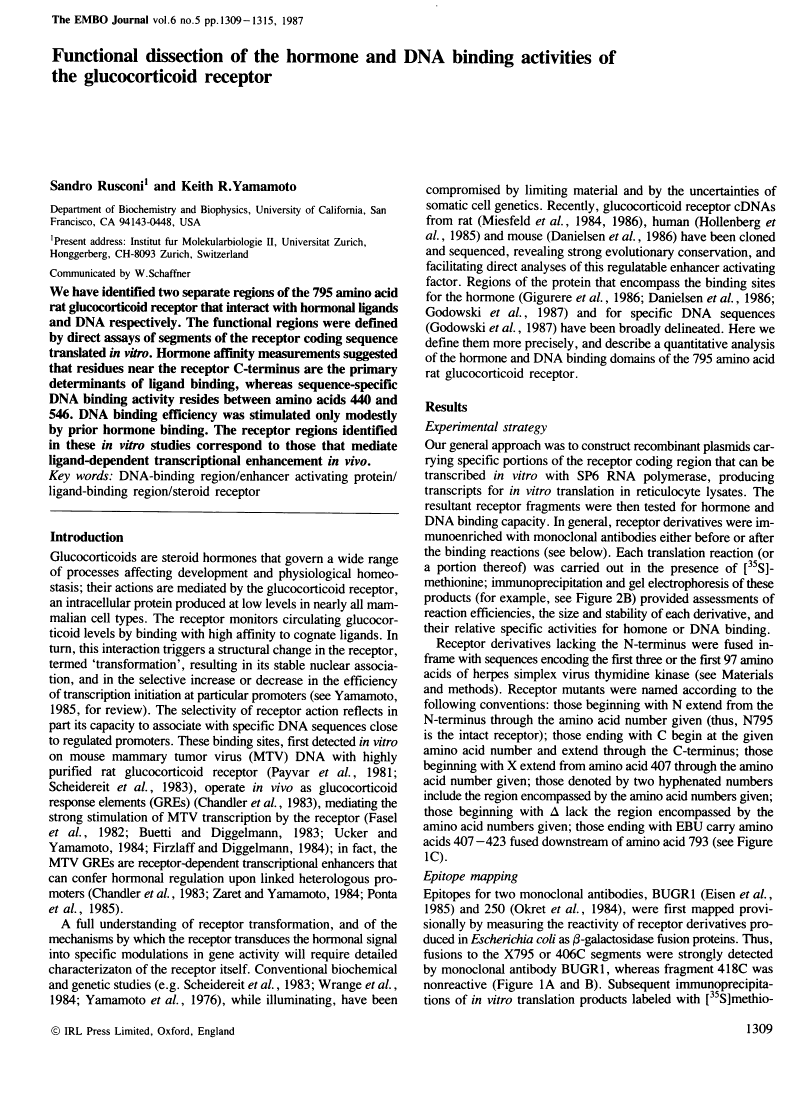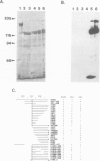Abstract
Free full text

Functional dissection of the hormone and DNA binding activities of the glucocorticoid receptor.
Abstract
We have identified two separate regions of the 795 amino acid rat glucocorticoid receptor that interact with hormonal ligands and DNA respectively. The functional regions were defined by direct assays of segments of the receptor coding sequence translated in vitro. Hormone affinity measurements suggested that residues near the receptor C-terminus are the primary determinants of ligand binding, whereas sequence-specific DNA binding activity resides between amino acids 440 and 546. DNA binding efficiency was stimulated only modestly by prior hormone binding. The receptor regions identified in these in vitro studies correspond to those that mediate ligand-dependent transcriptional enhancement in vivo.
Full text
Full text is available as a scanned copy of the original print version. Get a printable copy (PDF file) of the complete article (2.0M), or click on a page image below to browse page by page. Links to PubMed are also available for Selected References.
Images in this article
Click on the image to see a larger version.
Selected References
These references are in PubMed. This may not be the complete list of references from this article.
- Becker PB, Gloss B, Schmid W, Strähle U, Schütz G. In vivo protein-DNA interactions in a glucocorticoid response element require the presence of the hormone. Nature. 1986 Dec 18;324(6098):686–688. [Abstract] [Google Scholar]
- Buetti E, Diggelmann H. Glucocorticoid regulation of mouse mammary tumor virus: identification of a short essential DNA region. EMBO J. 1983;2(8):1423–1429. [Europe PMC free article] [Abstract] [Google Scholar]
- Carlstedt-Duke J, Okret S, Wrange O, Gustafsson JA. Immunochemical analysis of the glucocorticoid receptor: identification of a third domain separate from the steroid-binding and DNA-binding domains. Proc Natl Acad Sci U S A. 1982 Jul;79(14):4260–4264. [Europe PMC free article] [Abstract] [Google Scholar]
- Chandler VL, Maler BA, Yamamoto KR. DNA sequences bound specifically by glucocorticoid receptor in vitro render a heterologous promoter hormone responsive in vivo. Cell. 1983 Jun;33(2):489–499. [Abstract] [Google Scholar]
- Dahmer MK, Tienrungroj W, Pratt WB. Purification and preliminary characterization of a macromolecular inhibitor of glucocorticoid receptor binding to DNA. J Biol Chem. 1985 Jun 25;260(12):7705–7715. [Abstract] [Google Scholar]
- Danielsen M, Northrop JP, Ringold GM. The mouse glucocorticoid receptor: mapping of functional domains by cloning, sequencing and expression of wild-type and mutant receptor proteins. EMBO J. 1986 Oct;5(10):2513–2522. [Europe PMC free article] [Abstract] [Google Scholar]
- Eisen HJ, Schleenbaker RE, Simons SS., Jr Affinity labeling of the rat liver glucocorticoid receptor with dexamethasone 21-mesylate. Identification of covalently labeled receptor by immunochemical methods. J Biol Chem. 1981 Dec 25;256(24):12920–12925. [Abstract] [Google Scholar]
- Eisen LP, Reichman ME, Thompson EB, Gametchu B, Harrison RW, Eisen HJ. Monoclonal antibody to the rat glucocorticoid receptor. Relationship between the immunoreactive and DNA-binding domain. J Biol Chem. 1985 Sep 25;260(21):11805–11810. [Abstract] [Google Scholar]
- Fasel N, Pearson K, Buetti E, Diggelmann H. The region of mouse mammary tumor virus DNA containing the long terminal repeat includes a long coding sequence and signals for hormonally regulated transcription. EMBO J. 1982;1(1):3–7. [Europe PMC free article] [Abstract] [Google Scholar]
- Finer-Moore J, Stroud RM. Amphipathic analysis and possible formation of the ion channel in an acetylcholine receptor. Proc Natl Acad Sci U S A. 1984 Jan;81(1):155–159. [Europe PMC free article] [Abstract] [Google Scholar]
- Firzlaff JM, Diggelmann H. Dexamethasone increases the number of RNA polymerase II molecules transcribing integrated mouse mammary tumor virus DNA and flanking mouse sequences. Mol Cell Biol. 1984 Jun;4(6):1057–1062. [Europe PMC free article] [Abstract] [Google Scholar]
- Giguère V, Hollenberg SM, Rosenfeld MG, Evans RM. Functional domains of the human glucocorticoid receptor. Cell. 1986 Aug 29;46(5):645–652. [Abstract] [Google Scholar]
- Godowski PJ, Rusconi S, Miesfeld R, Yamamoto KR. Glucocorticoid receptor mutants that are constitutive activators of transcriptional enhancement. Nature. 1987 Jan 22;325(6102):365–368. [Abstract] [Google Scholar]
- Hollenberg SM, Weinberger C, Ong ES, Cerelli G, Oro A, Lebo R, Thompson EB, Rosenfeld MG, Evans RM. Primary structure and expression of a functional human glucocorticoid receptor cDNA. Nature. 1985 Dec 19;318(6047):635–641. [Europe PMC free article] [Abstract] [Google Scholar]
- Kumar V, Green S, Staub A, Chambon P. Localisation of the oestradiol-binding and putative DNA-binding domains of the human oestrogen receptor. EMBO J. 1986 Sep;5(9):2231–2236. [Europe PMC free article] [Abstract] [Google Scholar]
- Loose DS, Stover EP, Feldman D. Ketoconazole binds to glucocorticoid receptors and exhibits glucocorticoid antagonist activity in cultured cells. J Clin Invest. 1983 Jul;72(1):404–408. [Europe PMC free article] [Abstract] [Google Scholar]
- Melton DA, Krieg PA, Rebagliati MR, Maniatis T, Zinn K, Green MR. Efficient in vitro synthesis of biologically active RNA and RNA hybridization probes from plasmids containing a bacteriophage SP6 promoter. Nucleic Acids Res. 1984 Sep 25;12(18):7035–7056. [Europe PMC free article] [Abstract] [Google Scholar]
- Mendel DB, Bodwell JE, Gametchu B, Harrison RW, Munck A. Molybdate-stabilized nonactivated glucocorticoid-receptor complexes contain a 90-kDa non-steroid-binding phosphoprotein that is lost on activation. J Biol Chem. 1986 Mar 15;261(8):3758–3763. [Abstract] [Google Scholar]
- Miesfeld R, Okret S, Wikström AC, Wrange O, Gustafsson JA, Yamamoto KR. Characterization of a steroid hormone receptor gene and mRNA in wild-type and mutant cells. Nature. 1984 Dec 20;312(5996):779–781. [Abstract] [Google Scholar]
- Miesfeld R, Rusconi S, Godowski PJ, Maler BA, Okret S, Wikström AC, Gustafsson JA, Yamamoto KR. Genetic complementation of a glucocorticoid receptor deficiency by expression of cloned receptor cDNA. Cell. 1986 Aug 1;46(3):389–399. [Abstract] [Google Scholar]
- Miller J, McLachlan AD, Klug A. Repetitive zinc-binding domains in the protein transcription factor IIIA from Xenopus oocytes. EMBO J. 1985 Jun;4(6):1609–1614. [Europe PMC free article] [Abstract] [Google Scholar]
- Okret S, Wikström AC, Wrange O, Andersson B, Gustafsson JA. Monoclonal antibodies against the rat liver glucocorticoid receptor. Proc Natl Acad Sci U S A. 1984 Mar;81(6):1609–1613. [Europe PMC free article] [Abstract] [Google Scholar]
- Payvar F, Wrange O, Carlstedt-Duke J, Okret S, Gustafsson JA, Yamamoto KR. Purified glucocorticoid receptors bind selectively in vitro to a cloned DNA fragment whose transcription is regulated by glucocorticoids in vivo. Proc Natl Acad Sci U S A. 1981 Nov;78(11):6628–6632. [Europe PMC free article] [Abstract] [Google Scholar]
- Ponta H, Kennedy N, Skroch P, Hynes NE, Groner B. Hormonal response region in the mouse mammary tumor virus long terminal repeat can be dissociated from the proviral promoter and has enhancer properties. Proc Natl Acad Sci U S A. 1985 Feb;82(4):1020–1024. [Europe PMC free article] [Abstract] [Google Scholar]
- Rüther U, Müller-Hill B. Easy identification of cDNA clones. EMBO J. 1983;2(10):1791–1794. [Europe PMC free article] [Abstract] [Google Scholar]
- Scheidereit C, Geisse S, Westphal HM, Beato M. The glucocorticoid receptor binds to defined nucleotide sequences near the promoter of mouse mammary tumour virus. Nature. 1983 Aug 25;304(5928):749–752. [Abstract] [Google Scholar]
- Ucker DS, Yamamoto KR. Early events in the stimulation of mammary tumor virus RNA synthesis by glucocorticoids. Novel assays of transcription rates. J Biol Chem. 1984 Jun 25;259(12):7416–7420. [Abstract] [Google Scholar]
- Weinberger C, Hollenberg SM, Ong ES, Harmon JM, Brower ST, Cidlowski J, Thompson EB, Rosenfeld MG, Evans RM. Identification of human glucocorticoid receptor complementary DNA clones by epitope selection. Science. 1985 May 10;228(4700):740–742. [Abstract] [Google Scholar]
- Willmann T, Beato M. Steroid-free glucocorticoid receptor binds specifically to mouse mammary tumour virus DNA. Nature. 1986 Dec 18;324(6098):688–691. [Abstract] [Google Scholar]
- Wrange O, Okret S, Radojćić M, Carlstedt-Duke J, Gustafsson JA. Characterization of the purified activated glucocorticoid receptor from rat liver cytosol. J Biol Chem. 1984 Apr 10;259(7):4534–4541. [Abstract] [Google Scholar]
- Yamamoto KR. Steroid receptor regulated transcription of specific genes and gene networks. Annu Rev Genet. 1985;19:209–252. [Abstract] [Google Scholar]
- Yamamoto KR, Stampfer MR, Tomkins GM. Receptors from glucocorticoid-sensitive lymphoma cells and two clases of insensitive clones: physical and DNA-binding properties. Proc Natl Acad Sci U S A. 1974 Oct;71(10):3901–3905. [Europe PMC free article] [Abstract] [Google Scholar]
- Yamamoto KR, Gehring U, Stampfer MR, Sibley CH. Genetic approaches to steroid hormone action. Recent Prog Horm Res. 1976;32:3–32. [Abstract] [Google Scholar]
- Zaret KS, Yamamoto KR. Reversible and persistent changes in chromatin structure accompany activation of a glucocorticoid-dependent enhancer element. Cell. 1984 Aug;38(1):29–38. [Abstract] [Google Scholar]
Associated Data
Articles from The EMBO Journal are provided here courtesy of Nature Publishing Group
Full text links
Read article at publisher's site: https://doi.org/10.1002/j.1460-2075.1987.tb02369.x
Read article for free, from open access legal sources, via Unpaywall:
https://onlinelibrary.wiley.com/doi/pdfdirect/10.1002/j.1460-2075.1987.tb02369.x
Citations & impact
Impact metrics
Article citations
Repression of transcription by the glucocorticoid receptor: A parsimonious model for the genomics era.
J Biol Chem, 296:100687, 01 Jan 2021
Cited by: 23 articles | PMID: 33891947 | PMCID: PMC8141881
Review Free full text in Europe PMC
Phenotypic Nonspecificity as the Result of Limited Specificity of Transcription Factor Function.
Genet Res Int, 2018:7089109, 28 Oct 2018
Cited by: 0 articles | PMID: 30510805 | PMCID: PMC6230420
Review Free full text in Europe PMC
Modulation of nuclear receptor activity by the F domain.
Mol Cell Endocrinol, 418 Pt 3:298-305, 13 Jul 2015
Cited by: 16 articles | PMID: 26184856
Review
Identification and characterization of transcription factors regulating Arabidopsis HAK5.
Plant Cell Physiol, 54(9):1478-1490, 02 Jul 2013
Cited by: 36 articles | PMID: 23825216
Insights on glucocorticoid receptor activity modulation through the binding of rigid steroids.
PLoS One, 5(10):e13279, 11 Oct 2010
Cited by: 26 articles | PMID: 20949009 | PMCID: PMC2952596
Go to all (125) article citations
Similar Articles
To arrive at the top five similar articles we use a word-weighted algorithm to compare words from the Title and Abstract of each citation.
Identification of cysteine 656 as the amino acid of hepatoma tissue culture cell glucocorticoid receptors that is covalently labeled by dexamethasone 21-mesylate.
J Biol Chem, 262(20):9676-9680, 01 Jul 1987
Cited by: 43 articles | PMID: 3597435
Identification of hormone-interacting amino acid residues within the steroid-binding domain of the glucocorticoid receptor in relation to other steroid hormone receptors.
J Biol Chem, 263(14):6842-6846, 01 May 1988
Cited by: 35 articles | PMID: 3360809
Genetic analysis of the N-terminal end of the glucocorticoid receptor hormone binding domain.
J Steroid Biochem Mol Biol, 51(1-2):11-19, 01 Oct 1994
Cited by: 12 articles | PMID: 7947345
Affinity labeling of the rat liver glucocorticoid receptor with dexamethasone 21-mesylate. Identification of covalently labeled receptor by immunochemical methods.
J Biol Chem, 256(24):12920-12925, 01 Dec 1981
Cited by: 34 articles | PMID: 6895516
















